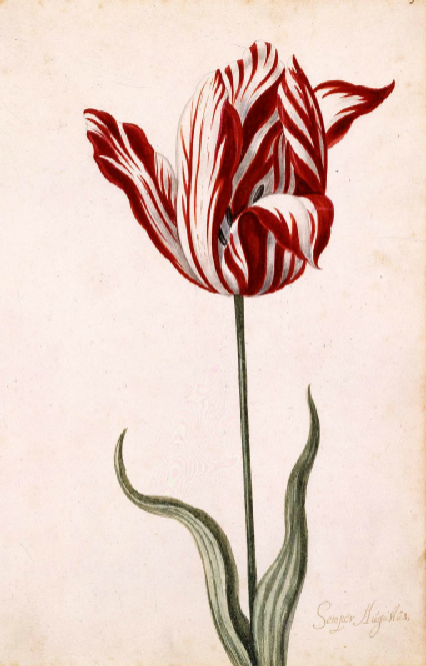Of course everyone on Steemit is aware of the current Cryptocurrency mania (with Steem prices having gone up 300% in the past month, it's been hard to miss), and it mirrors one of the earliest known financial manias: Tulipmania. But what's astounding, is that Tulipmania was actually caused by an infectious disease. Could an infection really have made people mad for tulips? Could crypocurrency mania be an infectious epidemic too?

Image Credit: Wikimedia Commons By Hisa Fujimoto
What Was Tulipmania
In case you haven't heard of Tulipmania, it's a lot like it sounds; people going crazy for tulips! People went SO crazy for tulips that, at its height, the highest confirmed price of a single bulb of the most prized specimen sold for 5200 Dutch guilders. At the time, Dutch guilders were real money, being comprised of 0.77 grams of gold per guilder, incidentally making it the soundest money in the world, which attracted to Holland the wealth that allowed the disposable income Tulipmania required (1).
This means the total amount of gold for a single sale of one bulb was 128 troy ounces, or what would be about $166,656 with the price of spot gold at $1302/troy ounce on January 1, 2018! Absolutely incredible! A year after the mania began, tulip prices had crashed to pre-mania levels, and have been a mainstay of Dutch culture ever since. Tulipmania started after a botanist brought some Tulip specimens back to Austria with him from their native home in the Ottoman Empire (now Turkey), and sold some to a rich Dutchman named Dr. Adriaen Pauw. Pauw, the director of the East India Company, often showed off his dozen or so specimens of Semper Augustus varietals, virtually the only specimens of this varietal in the world, to guests at his estate near Haarlem in Holland (2). When people offered higher and higher prices to buy the bulbs, his refusal to sell at any price is the purported spark for the ensuing financial mania.A Bit of Background on Tulipmania

Image Credit: Wikimedia Commons
In the small cramped gardens of the Dutch city dwellers, a boastful owner of a costly specimen might have a single flower as the centerpiece of the entire garden, and grace it with mirrors to multiply and amplify it's beauty.
Tulips were so desirable that, when that year's specimens went into the ground, people began financial speculation for first rights on the bulbs when they came out of the ground, just as futures traders might do today for corn and soy. But these were FLOWERS, what could cause this madness for just a flower?
Broken Tulips Fueled the Fire
One of the reasons for the mania of particular tulips was their rarity. For reasons unknown at the time, about 1 in 100 flowers would depart from the normal solid candy colored brilliance we are familiar with, and become variegated with colored streaks, an occurrence known as 'breaking'.
blue base, and with an unbroken flame right to the top.
Never did a Blommist see a more beautiful one than
this: no Tulip has ever been in greater esteem."
Nicolaes van Wassenaer. 1624

Image credit: Wikimedia Commons.
This tulip is what caused an entire financial bubble.
Would you have chosen this single flower, or a luxury house on the canal?
Some of the most beautiful and prized flowers were streaked even to the point of wild party dress and flaming patterns, like the Semper Augustus pictured above in a drawing from the time. These broken tulips could not be predicted, but because of their extreme beauty and rarity, became the most prized of all the tulips on the market.
What About the Infectious Disease
What tulipmaniacs could not have known at the time, but was finally discovered in 1927 by Dorothy Cayley of the John Innes Horticultural Institution in Norfolk, England, was that tulip breaking was caused by bulbs becoming infected with a virus carried by an aphid (Myzus persicae) (3) that commonly infests peach trees!

Image Credit: Wikimedia Commons
The green peach aphid unknowingly helped to start the biggest financial bubble of all time.
The Tulip Breaking Virus (TBV) works by damaging the cells that produce pigments called anthocyanins. When these color producing cells are suppressed, the underlying white or yellow color of the photosynethic producing plant tissue, known as the mesophyll, show through in the streaky variegated patterns the Dutch went mad for (4).
its original colour is usually ruined afterwards and wanted only to
delight its master's eyes with this variety of colours before dying,
as if to bid him a last farewell."
Carolus Clusius, A Treatise on Tulips (1601)
While the broken tulip's offspring would also have the beautiful variegation, in a tragic irony that fueled the flower market even more, the disease that caused the tulip's great beauty also caused it to weaken and shorten its generational life, only allowing a small and finite number of the most prized tulips to ever be cultivated.
While Tulipmania was caused by a communicable disease, this virus does not infect humans, so we can all be secure in knowing that Crypomania is almost certainly not caused by a communicable disease, or at least not the same disease that caused flowers to become worth more than gold, jewelry, and real estate in the 1600's, but Extraordinary Popular Delusions and the Madness of Crowds is a mysterious concept we are still not exactly sure of the cause.
Love science? Join us on the SteemStem project.

I've been spending a lot of time in the crypto world lately. 'Tulip mania' comes up a lot (as in, "My mom/friend/coworker tells me I'm stupid for investing in tulip mania").
It's an easy excuse to avoid the entire market.
The common response from crypto believers is "Pfft that's stupid crypto isn't a bubble/isn't even comparable to the tulip phenomenon."
Ironically, 99.9% of people calling crypto 'tulip mania', and 99.9% of the people mocking them claiming it isn't, have zero idea of the how's and why's of what tulip mania was, why it happened, etc.
They know people paid a billion dollars for flowers. That's it.
This article is my new standard I'll be posting anytime I see 'tulip mania' mentioned by either side.
Downvoting a post can decrease pending rewards and make it less visible. Common reasons:
Submit
Wow, thanks for this great post. What a super fun read. I knew about Tulipmania, but did not really know how it started or what it was about. And the part about the virus and Tulipmania being infectious? Kind of a bait and switch there, but a clever one to make us believe that the HUMANS were the ones infected but it was really the plants that were infected.
Downvoting a post can decrease pending rewards and make it less visible. Common reasons:
Submit
Well that was probably the most interesting thing I'll read today. Thanks for that!
Downvoting a post can decrease pending rewards and make it less visible. Common reasons:
Submit
I like to think that the Bitcoin split was done to isolate infected cryptocurrency.
Seriously good article. I think I vaguely knew of the history behind tulipmania, but I wouldn't have guessed a disease caused the prized phenotypes. If virologists existed back then they would have made millions of guilders.
Downvoting a post can decrease pending rewards and make it less visible. Common reasons:
Submit
"I like to think that the Bitcoin split was done isolate infected cryptocurrency."
That's an interesting take!
Downvoting a post can decrease pending rewards and make it less visible. Common reasons:
Submit
Perhaps I'm just not aware of the research into it if it exists, but I'm actually surprised no one has worked on a tulip that is resistant to the virus. Instead, horticulturists seek to eliminate it. Like the bortyritis fungus that makes some dessert wines, winemakers use the infection to their advantage rather than their detriment. it's the old saying that when life gives you lemons, make lemonade.
Downvoting a post can decrease pending rewards and make it less visible. Common reasons:
Submit
The first virologist could have made a fortune, but eventually it would have become too abundant. :) I wonder if anyone tried to color it with some substance or that would have killed the flower even faster anyways.
Downvoting a post can decrease pending rewards and make it less visible. Common reasons:
Submit
Nice article. I think both mania were quite different but both have a quite simple root cause called GREED. When prices rise double digit every week everybody want to be aboard :-)
Downvoting a post can decrease pending rewards and make it less visible. Common reasons:
Submit
A very interesting read, about Tulip mania. I have actually googled it after reading your article and it has really existed! It's amazing how many new things we can learn from each other here on steemit!
Downvoting a post can decrease pending rewards and make it less visible. Common reasons:
Submit
If you touch on any altcoins before 07/2018 you get infected with emptyWalletescleroses therefore, just HOLD the Door!
Downvoting a post can decrease pending rewards and make it less visible. Common reasons:
Submit
I like your post my friend
Downvoting a post can decrease pending rewards and make it less visible. Common reasons:
Submit
@originalworks
Downvoting a post can decrease pending rewards and make it less visible. Common reasons:
Submit
The @OriginalWorks bot has determined this post by @kerriknox to be original material and upvoted it!
To call @OriginalWorks, simply reply to any post with @originalworks or !originalworks in your message!
Downvoting a post can decrease pending rewards and make it less visible. Common reasons:
Submit
Don't worry, 99% of people have the opinion but don't have the knowledge.
If you don't trust me, just ask about the evolution, space, health, medicine...
Cryptos are not the tulips because the tulips are pointless, just nice flowers. And the tulips are not easy to be used as the currency.
From the tulip, you can only make - a tulip. Not a cosmetics, perfume, food while with the crypto you can.
For me, the fiat is the worst thing to HODL. Just look at the car prices. I bought my first car 5 years ago - now I can sell it for the same amount of Euros. I got the second one last year - the value is the same.
Entry level Ferrari was 20.000 in 2010 and now it's 50.000 Eur. And thousands of other examples...
Read the white paper, the blue paper, if it's logical - just do it + HODL
Downvoting a post can decrease pending rewards and make it less visible. Common reasons:
Submit
quite interesting, I did not know the true meaning of this term and all the history that surrounds it
Downvoting a post can decrease pending rewards and make it less visible. Common reasons:
Submit
Very interesting article and the way you wrote it made complete sense.
Let's all become part of Tulip Mania 2.0 and exit before the ways go down ;)
Downvoting a post can decrease pending rewards and make it less visible. Common reasons:
Submit
I watched some documentaries about the tulip mania but this is the first time I see this information about the TBV. Never would have thought that the real perpetrator were the aphids. I wonder what would be the reaction if they knew that they were done for by insects. Hehe. This post is refreshing to read. Thanks for sharing XD
Downvoting a post can decrease pending rewards and make it less visible. Common reasons:
Submit
Good post, thanks for sharing this information on new disease called Tulipmania, i hope that the science that discovered it will also discover the cure, Amen. I follow and upvote you.
Downvoting a post can decrease pending rewards and make it less visible. Common reasons:
Submit
I had no idea about this, I thought it was just a flowery fashion, but not an actual demand on the market for the rare species.
Everybody to it's own, we all have things we like and we are ready to invest to that likeness whatever we wish, regardless of others with the different taste think about it.
Downvoting a post can decrease pending rewards and make it less visible. Common reasons:
Submit
Tulipmania is alive and well! Love this post, keep it up! https://steemit.com/@muscleroast.com
Downvoting a post can decrease pending rewards and make it less visible. Common reasons:
Submit